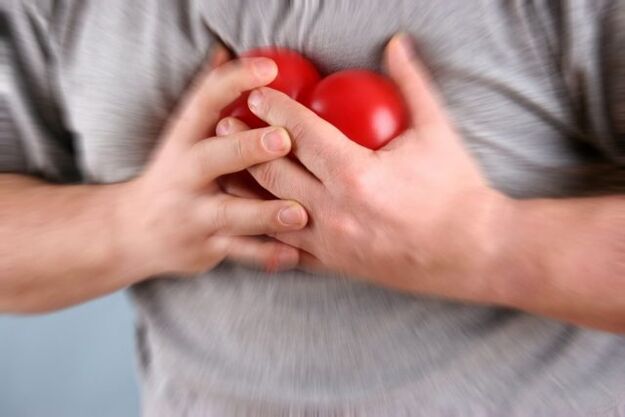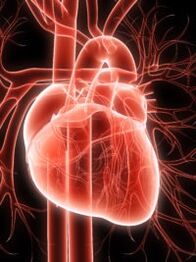Hypersonic disease is one of the most common pathology of the heart sphere and is currently diagnosed as the third inhabitant of our 45-year-old planet. The disease has become much younger in recent years and now often in high pressure patients, you can see very young high pressure patients. The main danger of pathological state lies in its complications. GB can lead to heart attacks and strokes, resulting in the collapse of the main vascular aneurysm, causing the development of overall impaired renal insufficiency, and deteriorating dramatically in visual quality.
The human blood pressure has an upper layer, heart rate or contraction value, as well as diastolic pressure or its lower kidney level. According to WHO standards, the specifications for these indicators should not exceed 139/89 mm Hg. Art, otherwise talking about high blood pressure is a habit. Early diagnosis and timely treatment of hypertension - A person can prevent the opportunity for pathological changes in many internal organs that will maintain health and enjoy years of fulfilling life.
reason
Unfortunately, modern medicine has not been able to fully address all possible causes of hypertension, but most of them are known as doctors. To determine which factor contributes to the development of the disease, only one experienced expert, who during the diagnosis process not only uses his knowledge, but also the results of many studies that confirm or refute a person's signs of hypertension.
The main reason for blood pressure growth is to violate the activity of a person's sympathetic-adrenaline system, i. e. , the continuous stimulation of the center of the blood vessels in the brain.
This can occur under the influence of many Exos, as well as endogenous factors that cause sudden cramps in blood vessels.
Symptoms of hypertension may occur in people with exogenous factors that have pathological status:
- frequent stress and severe nerve tone;
- Improper nutrition;
- A sedentary lifestyle;
- On irregular working days, night shift work;
- Consume regular large amounts of forced drinking and smoking;
- poison;
- Intensive exercise.
Among endogenous factors, the disease can stand out when it changes from a parent to a child, age and genetic poorness stands out. In addition, the development of hypertension helps:
- Atherosclerosis of vascular lesions;
- Obesity;
- Metabolic diseases, especially diabetes, hyperthyroidism;
- Kidney disease;
- Increased levels of calcium and sodium in the blood;
- Hormonal changes are the most common cause of high stress in women during pregnancy and menopause.
Classification
Currently, there are multiple categories of hypertension. The disease is usually distinguished by the nature of the course, the presence of complications, the cause of development, stress indicators, and more.
Modern cardiologists distinguish several hypertension (depending on the hypertension index):
- The pressure of 1 degree rises to 159-140/99-90 mm Hg. Art. ;
- 2 degrees to enable the arrow of the mechanical transmission gauge, indicator 179-160/109-100 mm RT. Art. ;
- 3 degrees - The continuous or periodic increase of pressure exceeds 180/110 mm Hg. Art.
According to the commonly accepted classification, the disease has such stages:
- The pressure in the first stage increases without damaging the target organ;
- 2 stages - Signs of internal organ damage, where the main targets are the heart, blood vessels, eye structure, brain and kidneys;
- Stage 3 - In the context of the development of complications, blood pressure increases steadily from the manifestation of a person who can die.
Hypertensive diseases have their own type of current, where:
- When pathological symptoms are very slow and persist for decades, benign types or slow GB variants and the risk of complications is assessed as minimal;
- A malignant disease is documented in which there are lesions with a sharp jump in stress, target organs and frequent hypertonic crises (this version of the disease is difficult to yield in drug treatment).
symptom
The disease is almost asymptomatic in the early stages of its development, complicating its early detection. In such patients, increased stress may be found by chance during physical examinations or during routine admissions at the clinic.

A more complex type of hypertension characterizes many characteristics, and these functions greatly deteriorate a person's quality of life, which is why he attracts experts. The main symptom of this disease is an increase in blood pressure to 140/90 mm Hg. Art. This condition can cause the development of headaches, which is the result of narrowing reflexes of blood vessels in the cerebral. Often, people who are prone to symptom complain about the pain in the neck and temples, which is pulsating, which is differentiated by their severity and sudden development. This pain and pulsation will not pass after taking painkillers.
Often, high blood pressure can feel solo dizzy, which can occur after performing simple work. Symptoms are usually accompanied by nausea and vomiting, as well as general discomfort due to increased intracranial pressure. When a person's ears are very leisurely, narrowing of blood vessels in the auditory instrument can cause ear noise, and he actually loses the ability to sense ambient sounds normally.
Violation of coronary blood can lead to the development of myocardial ischemia. Such patients have shortness of breath and rag pain, which can be used for nitrate correction. At this point, the organ works in an enhanced mode, and can push blood into a narrow trunk container in batches. Each attack of angina is accompanied by a rapid pulse, obvious heartbeat and risk, i. e. a powerful pathological state complication will appear as a myocardial infarction.
Through hypertension, the damage to the eyes with sharply deteriorated vision is determined and the development of hypertensive vascular disease in the retinal blood vessels is determined. The bottom of the eye is also involved in a pathological process, which swollen and squeezes the visual nerves. At this time, a man noticed "chicken skin ump", dark circles, etc. in front of his eyes.
Complications of high-pressure symptoms in women most often occur during menopause. During this period, hormone recombination occurs in weaker gender representatives, violating the production of biologically active substances that control normal stress levels. This is why hypertension is the most common outcome in women’s menopause.
complication
GB refers to the number of slowly developing sinister diseases and is often diagnosed when the first complication of the pathological process occurs. As the blood pressure of the target organ continues to rise, malnutrition and sclerotic changes occur, leading to serious functional diseases. First, the kidneys, brain, heart, vision analyzers and blood vessels suffer from arterial hypertension.

There are several risk factors that affect the development rate of complications and their severity:
- Bad habits, especially smoking;
- a sedentary lifestyle and an increase in weight index;
- Increased cholesterol in the blood and high blood sugar;
- Frequent stress;
- Deficiencies of potassium and magnesium in the body;
- age-related changes;
- Genetic tendency.
Due to hypertensive disease, the heart is forced to work under high load conditions, which is related to pushing blood into narrow blood vessels. Over time, the myocardial walls thicken, and in someone, the left ventricle of the myocardium and oxygen starve.
From the heart side, there are several types of hypertension complications:
- ischemic disease;
- Angina pectoris;
- atherosclerosis of the coronary artery;
- Acute form of heart failure in myocardial infarction;
- Chronic heart failure.
High levels of blood pressure stimulate the emergence of a person's brain disease, which in fact shows severe dizziness, headaches, ears, reduced memory, etc. There are several options for complex brain complications of hypertension:
- Brain disease has vestibular disease;
- ischemic and hemorrhagic strokes;
- Cognitive impairment in brain activity.
As you know, the kidney controls the amount of water and salt in the body. But as blood pressure rises, they can fully perform the main work. This leads to the emergence of many complications, among which:
- renal failure;
- Violating the function of filtering and releasing fluids;
- Kidney sclerosis.
This disease leads to the development of multiple symptoms in hypertension, which suggests the pathology of the kidneys. A patient begins to complain about common weaknesses, discomfort, emergence, unreasonable nausea.
The failure of the eyes is reflected in bleeding in the retina, edema of the optic disc and gradual loss of vision. In peripheral blood vessels with arterial hypertension, the most powerful complication is the stratification of its walls, especially known aortic aneurysms that have no symptoms in the formation and often lead to sudden and fatal results.
diagnosis
Through the establishment stage and the degree of disease development, diagnosing GB is an important step towards adequate treatment of pathological conditions. That's why when the first sign indicates a hypertensive disease, you should contact the healthcare facility immediately to find out what is causing the increase in stress and corrections.

If hypertension is suspected, a range of diagnostic measures include many laboratory and tool studies, including:
- Laboratory blood tests allow you to determine levels of potassium and magnesium, creatinine, harmful cholesterol, glucose, and more;
- Biochemical examination of urine was performed by measuring protein mass;
- electrocardiogram (ECG);
- Ultrasound of the heart;
- Doppler float;
- Check the fundus.
The diagnostic procedure for hypertension (which allows determination of the degree of disease) consists of two stages:
- The first phase is to determine the clinical manifestations of the disease from the discourse of hypertension and obtain the results of other studies.
- The second phase is a special study that allows you to determine the exact extent of the disease using magnetic resonance therapy (MRI) or X-rays and its complications in your patients.
Daily blood pressure monitoring can accurately understand the course of the disease. Thanks to it, you can set the range of stress fluctuations throughout the day and determine its average metric, which will characterize the degree of hypertension. The main disadvantage of such research is its high cost.
treat
Treatment of exacerbated hypertension should be carried out in heart hospitals where blood pressure levels may be continuously controlled. In addition, if necessary, the doctor can modify the patient's treatment plan and prescribe more effective medication for him in each specific clinical situation.
They began to treat the disease by appointing a special diet that strictly restricts cream, fat and fried dishes, as well as smoked meat, flour products of the viscera. Hypertensive nutrition is designed to improve general conditions, prevent the development of edema, normalize weight, etc.
According to the new European recommendations, treatment of GB must be comprehensive and must include many drugs whose effects are intended to lower blood pressure and eliminate the risk of malignant versions of the disease or complications of pathological states that convert the disease into its course. In the group of patients with the most commonly used hypertensive drugs, it should be distinguished:
- Alpha neighborhood;
- Gangster;
- ACE inhibitors;
- beta blockers;
- calcium channel blockers;
- Diuretic.
Doctors pay special attention to appointing diuretics. The truth is, not every diuretic is safe for the body with high blood pressure, because its properties wash potassium. This is why the use of such drugs should be combined with the use of potassium preparations under the control of blood biochemical composition. Additionally, diuretics not only reduce stress, but also eliminate tissue edema by excreting excess sodium.
It is strictly prohibited to treat hypertension independently.
It is also not recommended to use traditional medical antihypertensive drugs without coordination with the subject doctor. Action prohibition, as the primary contraindication, may cause an emergency hypertension crisis and require direct indoor clarification of the causes of complications in patients in specialized hospitals and addressing the problem of further elimination strategies.

prevention
To prevent hypertension, a series of measures aimed at promptly detecting and eliminating the development of pathological states and stabilizing the increased stress. To prevent the first sign of this disease, a person should normalize his lifestyle, give up bad habits and consume salt, increase his physical exercise and lose weight. Special attention should be paid to potential patients with risk of hereditary hypertension. People in this category should always measure pressure at hand, through which they can monitor their condition.
You can warn of the occurrence of blood pressure disease if:
- Live an active lifestyle (medical sports, fitness, massage, fresh air walks, skiing, swimming in the pool) and regularly train in the gym;
- Give up harmful foods, smoke and not drink alcohol;
- Reduce the use of salt to 3-4 grams per day;
- It is forbidden to eat foods containing high levels of animal fat, preservatives, and cholesterol;
- Observe clear daily work and practice adequate sleep;
- Prevent excess fat deposits, which can cause obesity;
- Prevent stressful situations;
- Regularly receive preventive examinations from cardiologists and perform necessary tests;
- Seek medical help right away when the first sign of increased stress appears.
People who have a trend toward hypertension should pay attention to their health, exercise and check regularly. Complete diagnosis of GB means pharmacy observation of the patient and sending it to the committee if necessary to establish a disability.















